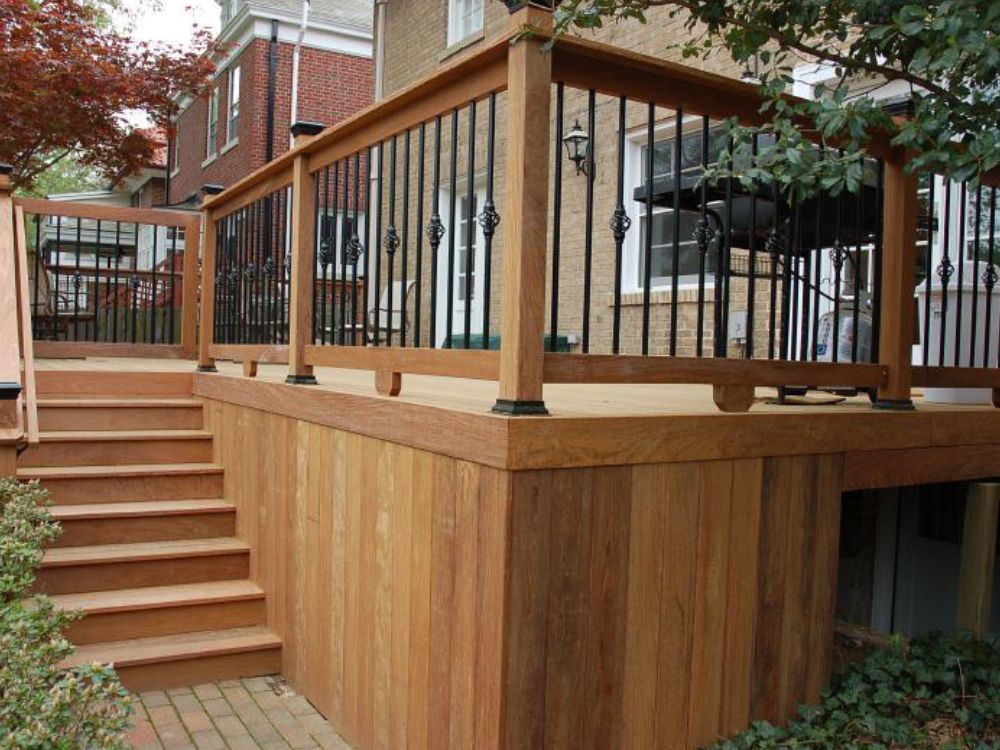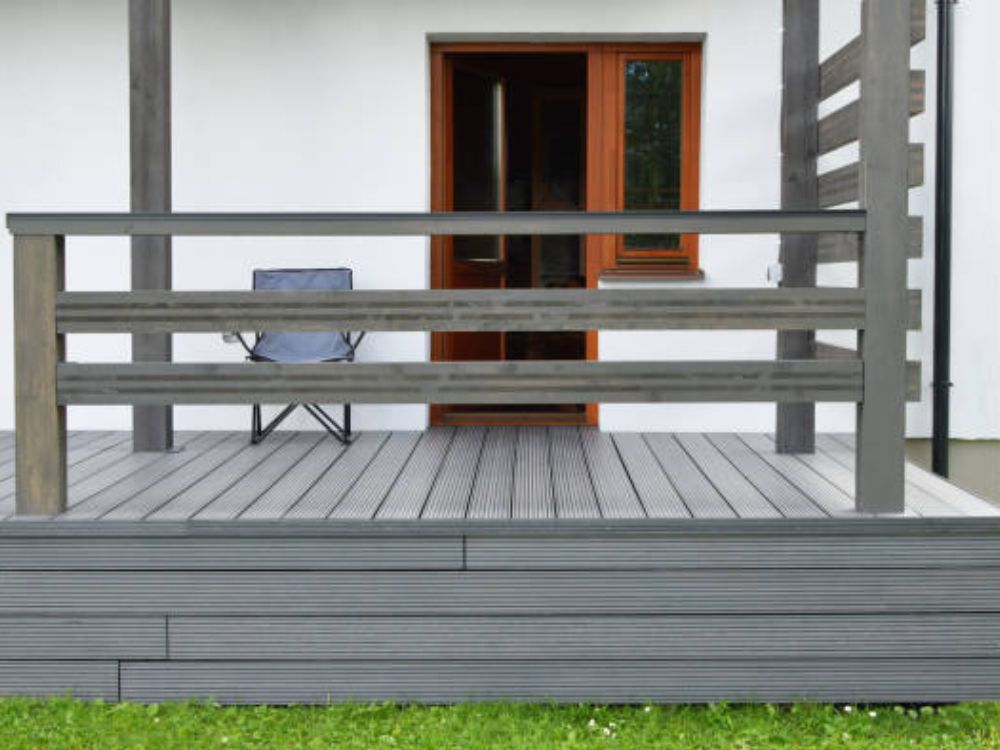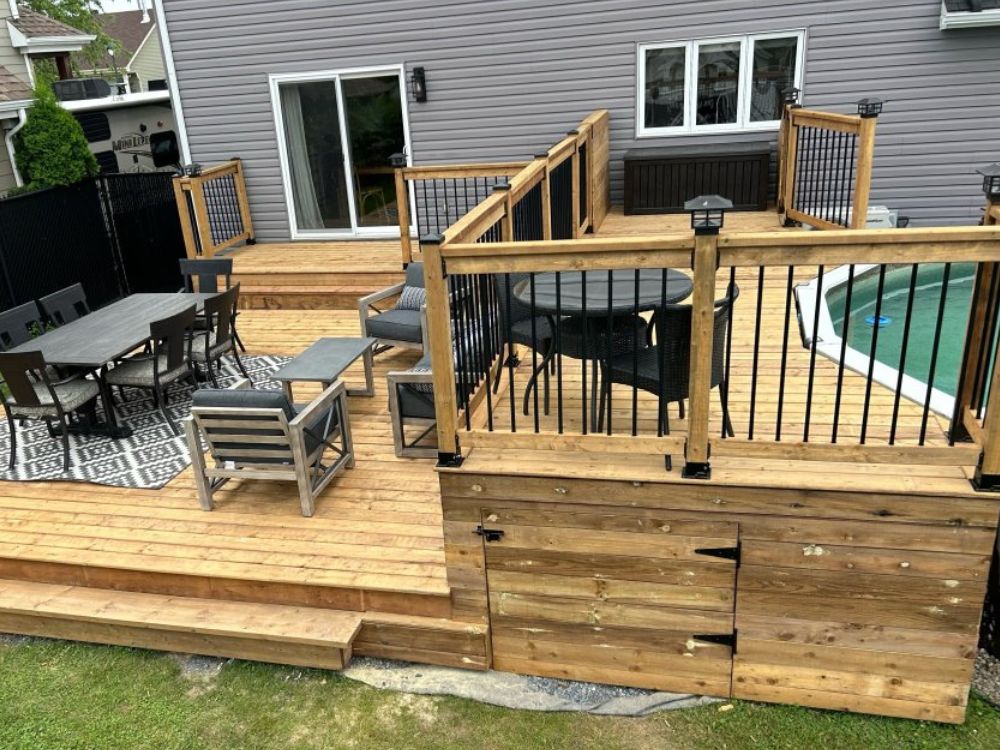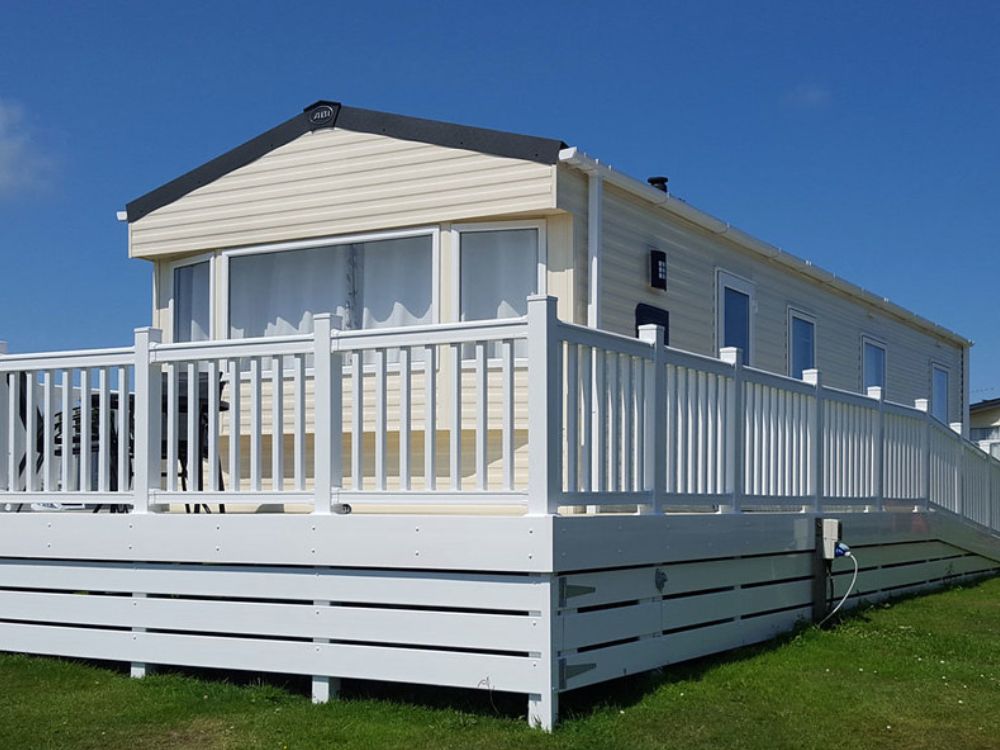Last Updated on October 20, 2025 by teamobn
Upgrading your deck skirting can transform a plain platform into a polished outdoor retreat. It creates a clean line that hides unsightly structural elements. It also boosts curb appeal. Many homeowners overlook this simple design feature. In this article, you’ll find ten inspiring deck skirting ideas that blend form and function.
Contents
Deck Skirting Ideas
Deck skirting ideas offer a simple way to conceal under-deck space and enhance curb appeal. These creative solutions range from classic lattices to modern composites.
Lattice Panel Skirting
Lattice panel skirting offers a timeless look that suits many styles of outdoor decks. It features a crisscross pattern that allows airflow and light to pass under your platform. Many homeowners choose this option among deck skirting ideas because it remains budget-friendly and easy to install.
Panels come in wood or vinyl versions, so you’re free to match your deck’s color. You’ll find different grid sizes that provide varying levels of privacy and ventilation. Maintenance involves routine cleaning and occasional repainting or staining to keep the lattice looking fresh and durable. It also deters pests by covering gaps where critters could nest.
Horizontal Wood Slats
Horizontal wood slat skirting brings a sleek, modern vibe to your deck. It uses evenly spaced boards laid side by side to create a streamlined appearance. This approach ranks among the top deck skirting ideas for contemporary homes. You can choose cedar or redwood for natural resistance against rot and insects.
Custom staining lets you match or contrast the color of your decking. Installation involves securing furring strips first to ensure proper alignment. You’re able to adjust slat spacing to allow airflow without sacrificing privacy, and occasional sealing will protect wood from weathering effects. Some homeowners add hidden LED lighting behind the slats for subtle ambiance.
Vertical Tongue and Groove Boards
Vertical tongue and groove board skirting creates a clean and polished look. Interlocking boards fit tightly together, creating a seamless facade. It is a popular choice among deck skirting ideas for its sturdy construction and timeless style. Pine or cedar boards work well since they resist warping when properly maintained.
Installation is straightforward if you secure a frame under your deck first. You’re able to paint or stain the boards to complement your house exterior. Regular inspections will catch any swelling or gaps early so you can sand and reseal as needed. This style also improves insulation under the deck by reducing drafts.
Stone or Faux Stone Veneer
Stone or faux stone veneer skirting adds a luxurious finish without the heavy cost of full masonry. Thin veneers mount directly onto plywood backing and mimic granite, slate, or brick.
It ranks high in creative deck skirting ideas for those seeking a natural, upscale aesthetic. Faux stone panels come in lightweight, durable composites that resist moisture and fading. You’ll need proper mortar and mesh tools to attach real stone veneers.
DIY kits for faux versions simplify installation with interlocking panels. Occasional cleaning with mild detergent keeps grout lines crisp and texture defined. This skirting option also shields the deck’s understructure from pests and weather damage.
Metal Grille Inserts
Metal grille insert skirting delivers a sleek industrial look that suits modern and rustic decks alike. Steel or aluminum grilles attach to a frame creating durable vented panels. They appear in several patterns such as geometric or linear grids.
Many people pick this option from deck skirting ideas when they want low-maintenance, long-lasting protection. Powder-coated finishes prevent rust and allow for colorful accents.
Grilles let air circulate to prevent mold and mildew under the deck. Installation is as simple as screwing panels into joists, and occasional rinse with a hose removes debris. You can even pair grille sections with planter boxes to soften the metal finish.
Outdoor Fabric Panels
Outdoor fabric panel skirting uses weatherproof textiles stretched over a frame to conceal under-deck areas. Fabrics come in durable, UV-resistant options like Sunbrella so they won’t fade or mildew. T
his approach ranks among flexible deck skirting ideas since you’re able to swap patterns with the seasons. Installation involves building a simple wooden frame under the deck and attaching fabric with staples or Velcro strips.
You can choose solid colors for a clean look or bold prints for a playful accent. Maintenance requires periodic cleaning to remove dust and dirt and occasional re-tensioning to prevent sagging.
Decorative Vinyl Panels
Decorative vinyl panel skirting offers intricate patterns molded into low-maintenance vinyl sheets. Popular motifs include trellis, Moroccan tile, or floral designs. Panels slot into a frame or slide directly onto tracks for a snug fit. The vinyl material resists moisture, pests, and fading, making it ideal for low-care applications.
You can cut panels with a utility knife to fit odd angles and curves. Cleaning is easy since vinyl wipes down with mild soap and water. This option blends the decorative appeal of carved wood with the durability of composite materials.
Recycled Pallet Panels
Recycled pallet panel skirting repurposes wood pallets to create a rustic, eco-friendly facade. You dismantle pallets and use select boards to form vertical or horizontal panels. Each piece carries unique grain patterns, giving your deck a charming, one-of-a-kind look.
This budget-friendly option encourages sustainable practices by reusing materials that might otherwise go to waste. Boards require sanding to smooth rough edges and a coat of sealant to protect against moisture. You’re able to leave natural patina or apply a colored stain to coordinate with your outdoor design. Regular sealing is key to preserving the wood’s integrity.
Live Plant Skirting
Live plant skirting transforms the space beneath your deck into a living green border. Climbing vines like ivy or clematis grow up trellis panels or hanging baskets attached under the deck. This approach softens hard lines and adds seasonal color to your outdoor area. You’ll need proper soil pockets or planter boxes integrated into skirting frames.
Regular watering and pruning keep plants healthy and prevent overgrowth. Some homeowners mix flowering annuals with evergreen groundcovers for year-round interest. Live plant skirting also deters pests and provides habitat for beneficial insects while concealing unsightly gaps.
Composite Material Boards
Composite material board skirting uses engineered boards made from recycled wood fibers and plastic binders. These panels mimic natural wood grain without the drawbacks of rot or splintering. They resist insect damage and require no staining or sealing.
Many brands offer tongue-and-groove composite boards for a seamless finish. You install them just like wood boards using hidden fasteners or face screws for a clean look.
Composite skirting matches composite decking for a unified design. A simple wash with soap and water restores its appearance while keeping maintenance minimal over the years.
Benefits of Deck Skirting
Adding skirting beneath your deck hides structural elements and creates a polished finish. It transforms wasted space into an aesthetic asset.
Enhanced Aesthetic Appeal
Skirting instantly upgrades the look of your deck by providing clean lines and a cohesive design. It conceals unsightly beams, plumbing, or storage areas under the deck. You can choose materials and colors that complement your home’s exterior.
Well-styled skirting turns what was once an afterthought into a focal point. It also makes your outdoor living space feel more intentional and complete.
Improved Pest Control and Moisture Management
Skirting acts as a barrier against rodents, snakes, and insects searching for shelter. By sealing gaps, it prevents critters from nesting beneath your deck. Proper ventilation panels or vents can still allow airflow and prevent mold or mildew buildup.
Moisture management reduces wood rot and extends the longevity of deck joists. This blend of protection and breathability keeps the space dry and pest-free.
Additional Insulation and Storage Space
A closed-in under-deck area creates natural insulation, moderating temperature swings in both your deck and the space beneath. During colder months, skirting helps retain heat and can reduce energy loss for homes with enclosed crawl spaces.
It also creates a hidden storage zone for garden tools, bicycles, or outdoor cushions. You can install hooks or shelves under the deck to organize gear. This dual function keeps belongings secure and out of sight.
Increased Privacy and Security
Deck skirting ideas create a solid barrier that shields the space beneath your deck from view. It enhances privacy by preventing onlookers from seeing stored items or pets.
Sturdy materials such as wood boards or composite panels block gaps and deter intruders and stray animals. You can integrate lockable access panels to keep essentials secure. This added layer of privacy and security makes your outdoor living space feel more secluded and safe.
Common Mistakes to Avoid with Deck Skirting
Selecting the right material influences durability, appearance, and upkeep needs. Each option offers unique benefits and maintenance requirements.
Wood Board Options
Natural wood boards like cedar, redwood, or pressure-treated pine deliver classic warmth and texture. Cedar and redwood resist decay and insects without chemical treatments. Pine requires sealing or staining to protect against moisture but offers an economical choice.
All wood options benefit from annual staining or sealing to maintain color and shield against weathering. Scratches or minor damage can be sanded and refinished, extending the life of your skirting.
Low-Maintenance Composite and Vinyl
Composite and vinyl panels mimic wood grain without the chores of painting or sealing. They resist rot, fading, and insect damage for years with a simple annual wash. Many products feature interlocking designs or hidden fasteners for a seamless look.
They come in a range of colors and textures, so matching existing decking is easy. While the upfront cost is higher, reduced maintenance time and long lifespan often justify the investment.
Metal and Stone Veneer Choices
Metal grilles offer strong, modern skirting that never rusts when powder-coated. They provide excellent airflow and require only occasional rinsing to remove debris. Stone or faux-stone veneers add natural elegance and shield the understructure from moisture.
Real veneer needs mortar and grout maintenance, while lightweight faux panels click together for quick DIY installs. Both options stand up to harsh weather and deliver a premium finish.
Creative Styling and Seasonal Decoration Ideas
Consider factors like climate, style, and budget before selecting skirting. The right choice balances function with design.
Climate and Ventilation Requirements
In humid or rainy regions, adequate airflow under the deck prevents mold, mildew, and wood rot. Choose slatted, lattice, or perforated materials to promote ventilation. In colder climates, solid panels or insulated skirting can help retain heat beneath the deck.
Evaluate local weather patterns to determine the optimum balance between airflow and protection. Proper installation of vents or removable panels offers seasonal flexibility.
Style and Architectural Harmony
Your skirting should echo the architectural features of your home and landscape. Traditional houses pair well with classic wood boards or lattice designs. Modern homes benefit from sleek composite panels, metal grilles, or stone veneers.
Consider color, texture, and pattern when matching existing siding, trim, or hardscaping. A cohesive palette ensures a seamless transition from house to deck. Preview samples in natural light before finalizing your choice.
Budget and Long-Term Maintenance
Initial costs vary widely between basic lumber, mid-range composites, and premium stone veneers. Factor in installation expenses and anticipated maintenance over the skirting’s lifespan.
Low-maintenance options may cost more upfront but save time and money on staining or repairs. DIY-friendly materials reduce labor costs, while complex veneers often require professional installation. Establish a clear budget that accounts for both purchase and upkeep to avoid surprises.
Materials for Deck Skirting and Maintenance
Choosing the right skirting material ensures lasting beauty and function. It also affects upkeep and budget. Each option offers unique charm and care needs.
Wood Board Options
Natural wood boards bring warmth and a classic feel to your deck. Cedar and redwood resist decay and insects naturally. They add rich tones that blend with outdoor surroundings. Pressure-treated pine gives affordable durability. You can stain or paint wood boards to match your home’s exterior.
You’re able to choose straight-grain or knotty patterns for extra character. Wood is simple to cut and install with basic tools. You’ll need to seal it yearly to guard against moisture and UV damage. A fresh coat of stain keeps wood looking new and protects it from weather. Minor scratches and dents can be sanded and refinished easily.
Composite and Vinyl Materials
Composite and vinyl panels mimic wood without the chores of painting or sealing. They resist rot, fading, and insect damage for years. You only need to rinse panels with a hose to keep them clean. Many brands offer interlocking designs for a seamless finish and hidden fasteners for a sleek look.
Vinyl is lightweight and easy to cut with a utility knife. Composite boards often match composite decking for a unified appearance. Both materials cost more upfront but save time and money on maintenance. You’re free to match or contrast your deck’s color. This low-care option suits busy homeowners and high-moisture climates.
Metal and Stone Veneers
Metal grilles and stone veneers deliver modern and rustic flair. Powder-coated steel or aluminum panels resist rust and stand up to weather. They provide ventilation and block pests while adding architectural interest.
Stone or faux-stone veneers offer an upscale finish. Real stone requires mortar and grout work, while faux panels click together for quick DIY installs. Both shield your deck’s underside from moisture and critters. You’ll only need to rinse metal grilles or scrub stone veneers occasionally.
These materials come in diverse patterns and colors. You’re able to pick a look that suits your home’s style. This premium choice withstands wear and adds lasting value.
Fabric and Live Green Options
Outdoor fabric screens cloak under-deck areas in style. UV-resistant textiles stretch over simple frames and resist fading and mildew. You can swap panels each season for fresh designs. Installation only needs a wood frame and staples or Velcro.
Live green options use plants, vines, and planter boxes to conceal gaps. Climbing ivy or clematis grows up lattice or trellis panels. You’ll water and trim plants regularly to keep them healthy. This eco-friendly skirting blends hardscape and landscape.
You’re able to create a living curtain under your deck that adds color and texture. Both fabric and green options offer unique flair and seasonal variety.
Maintenance Strategies
Regular care keeps skirting looking its best and extends its lifespan. Inspect panels at least once a year for loose boards, rust spots, or fabric tears. You can tighten fasteners or reattach staples as needed. Wash vinyl and composite with mild soap, then rinse thoroughly.
Wood boards need an annual coat of sealant or stain to protect against sun and rain. Stone grouts may require re-pointing over time, while metal grilles benefit from spot-treating any rust. Trim climbing plants and replace worn fabric panels promptly.
A small investment in maintenance prevents costly repairs down the road. You’re able to preserve both beauty and function with these simple routines.
Conclusion
Deck skirting transforms a bare under-deck area into a polished outdoor feature. It hides structural elements and adds insulation and storage space. It also boosts curb appeal and deters pests. Choosing the right material and installing it properly ensures lasting style and function.
Do you still need more ideas to boost the functionality and look of your deck? Check out our guide on improving your home deck next!






